
| Tikal Scientific Information Center | Tikal's Meteorological Information |
| Tikal's Hydrology | Tikal's Ecology | Tikal's Flora | Tikal's Fauna |
| Tikal's Mammals | Tikal's Felines | Tikal's Bats | Tikal's Birds | Tikal's Insects | Tikal's Reptiles | Tikal's Amphibians |
| Tough to Spot |
Tough to Spot
Bairdi's Tapir or Danta (in Spanish)
Order: Perissodactyla
Family: Tapiridae
Species: Tapirus bairdii
Baird’s Tapir is identified by their particular body shape, their head and legs are a uniform blackish brown, their head has a flat crown, and their mane is often poorly developed or absent. Their proboscis is slightly longer, ad their lower cheeks and chest are usually a bit more whitish or grayish while their body is more often reddish. The small young tapirs are chestnut-red with white stripes and spots, while the older young are browner. They are similar with the Brazilian Tapir (Tapirus terrestris) and Capybaras (Hydrochaeris hydrochaeris). When surprised the may stamp their feet loudly. They communicate with a loud whistle (unfortunately, they answer imitations of this call made by hunters, who then easily find and shoot them).
Baird’s Tapirs are nocturnal and diurnal, terrestrial and usually solitary, while family groups seem to use a small area. They spend almost 90% of their waking time feeding on browse, grass, and fruits. Sometimes they sleep in the water. They are found in rainforest and montane forests, swamps, and flooded grasslands throughout Central and South America. They are threatened by hunting and deforestation. (CITES, Appendix I)
Their local names are: Tapir, anta, danta, macho de monte, danto, and antiburro in Spanish, tzimin in Mayan and receive the name of mountain cow in Belize.
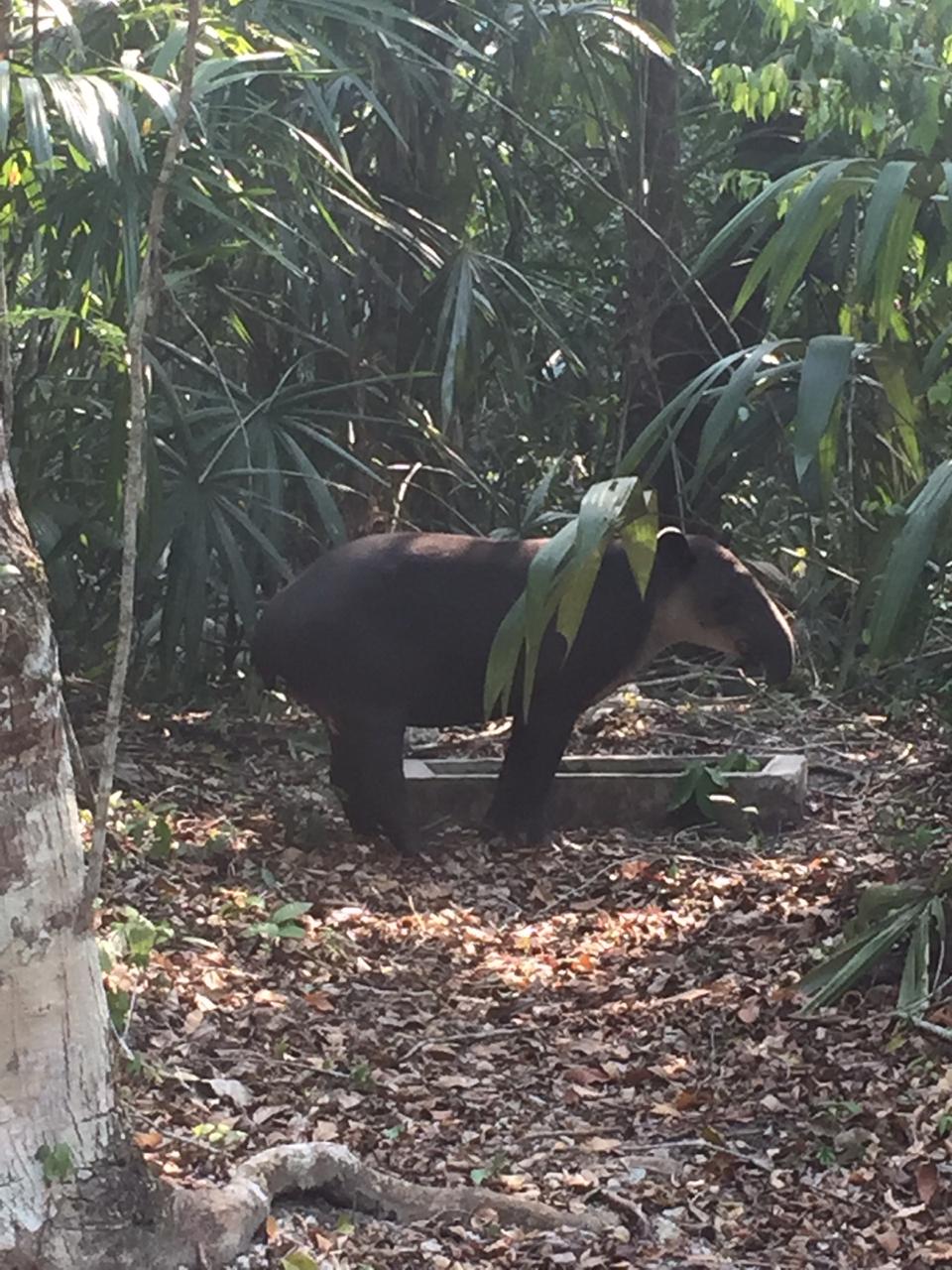
Young tapir or danta, Tapirus biardii
The possibility of survival for this species depends on us... all of us... together. Enjoy this great video about the state of conservation of Baird's tapir or "danta". Act today!!!
Anteater or Northern Tamandua
Superorder: Xenarthra (formerly within Edentata)
Order: Pilosa
Family: Myrmecophagidae
Species: Tamandua mexicana
The Tamandua Mexicana is externally identical to the Southern Tamandua except that the Northern Tamandua is distinguished from it by characters of the skull. All individuals are black vested. Similar species are the monkeys, which have a short muzzle and Giant Anteaters (Myrmecophaga tridactyla), which have bushy tails and are much largera
They are diurnal and nocturnal, arboreal, terrestrial and solitary. It feeds mainly on ants, termites, and bees extracted after ripping apart their nests with their fore claws. Tamanduas can be seen foraging on the ground or in the canopy anywhere in the forest, but seem most common beside watercourses and epiphyte-laden habitats, where their prey may be concentrated. By day in the rainforest a dense cloud of flies and mosquitoes accompanies them so they often brush their eyes with a forepaw. When inactive, tamanduas rest in hollow trees, burrows of other animals or other natural shelters.
Their geographic range is Central and South America; from the south of Mexico throughout all of Central America and in South America in the west of the Andes and from Northern Venezuela to Northern Peru. They are threatened by habitat destruction in much of its range (CITES Apendix III)
Their local names are: Oso Hormiguero, Tamanduá, Susurete, Oso Amarillo, Brazo Fuerte, Oso Mielero in Spanish, it’s called an ant bear in Belize and in Mayan it is called Chab.
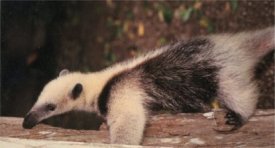
Baby tamandua, Tamandua mexicana
Kinkajou
Order: Carnivora
Family: Procionidae
Species: Potos flavus
Kinkajous are identified by their reddish brown to smoky gray-brown upper parts, often with a dark brown stripe on mid-back. Their fur is dense, soft and short (about 1 cm at mid-back). Their heads and faces are red-brown to blackish; their heads round, their muzzles short and pointed. Kinkajous have brown noses, large and round brown eyes, which are set wide apart. They have brown, thinly haired ears, set low on the sides of their heads, and they have a long, highly extensible tongue. Their prehensile tails are slightly longer than their heads and bodies, tapered toward the tip, and are brown or dark to black at the tip.
Their feet are colored like their backs, all with five long, curved claws. Their under parts are a contrasting yellow to pale orange buff. Kinkajous are agile, muscular, short-legged, long-backed, monkeylike animals. In Central America they are grayish-brown. Similar species include Olingos (Bassaricyon sp.), Cacomistles (Bassariscus sumichrasti) and Night Monkeys (Aotus sp.).
The kinkajou’s sounds are highly vocal: when alarmed they emit sneezing whistles and jump noisily from tree to tree at night. They are nocturnal, arboreal, solitary and may live in pairs. Several kinkajous may congregate in a fruit tree. They feed on fruit, primarily figs (Ficus sp.) and insects, especially ants, and in the dry season they drink flower nectar.
Kinkajous are animals of the forest canopy, and they are the most commonly seen large, nocturnal and arboreal mammals. They are agile and can travel quickly, running and jumping noisily from tree to tree. They are found in mature, disturbed, and secondary rainforest, gardens and plantations, gallery forest, and occasionally in deciduous forests. They live in Central and South America, where they are widespread and common. However, they are hunted for meat and for the pet trade. (CITES Appendix III)
Kinkajous are called mono michi, jupará, perro de monte, oso mielero, leoncillo, micoleón, marta, martucha, martilla, martica, tutamono, chuche, cuchicuchi, cusumbo, chosna and martucha in Spanish and nightwalker in Belize.
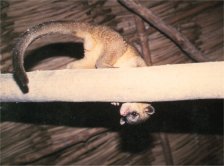
Kinkajou, Potus flavus
Northern Raccoon
Order: Carnivora
Family: Procionidae
Species: Procyon lotor
Its grizzled blackish gray upper parts and its long and soft fur identify the Northern Raccoon. Its head is broad, with a pointed muzzle, while its face is white with a broad black mask reaching across and well behind eyes to nearly below its ear and extending below. It has a sharply contrasting brown bar across its throat. Its nose is black; its relatively large ears are white inside and out. It has medium-sized eyes, with a bright greenish white-eye shine at night. Its moderately bushy tail is about 60% as long as its head and body, it has broad, brightly contrasting black and gray or buff rings. Its under parts are whitish, covered with long and white hairs, with a soft brown under fur showing below. Its forelegs are whitish, with hind legs and feet usually whitish, but sometimes brown.
Its shape and posture is like that of the crab-eating raccoon, with which it bears a strong similarity.
Their sounds are a variety of whines, yips and growls, not usually heard in the field. Northern Raccoons are nocturnal, terrestrial and arboreal, solitary except females with young. There may be congregations of them at food sources. They feed on fruits and small animals, especially aquatic ones, such as crayfish, crabs, and fish; they also raid garbage and dumps and are a pest when it eats young ears of corn.
Northern raccoons are common on the beaches of both coasts of Central America and are also found inland in mangrove swamps and near rivers. They adapt well to man and thrive in towns and cities. They live in North and Central America; its status is widespread and common.
Northern Raccoons are also called mapache, osito lavador, zorra manglera and pizote solo in Spanish, and tzil in Mayan.
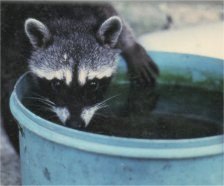
Mischievous raccoon, Procyon lotor
Tayra
Order: Carnivora
Family: Mustelidae
Species: Eira barbara
Tayras are identified by their glossy, dark brown to black upper parts, legs, feet and tail. The fur on their heads is short and stiff, while the fur on the body and tail is long and glossy. Its under fur is brown. The head and neck sharply contrast with a grizzled tan on the back, which may be a gray-brown or yellowish color, but is rarely dark brown or the same. Their ears are small and round, the same color as the head, and not protruding above the crown. Their under parts are completely black or dark brown, except for a bright pale yellow to orange spot, often triangular, on their chest and throat. Their tail is bushy, and about two-thirds as long as their head and body. Partial webs that reach to the base of the last joint join their toes. Tayras are muscular large weasels, much like a small dog with long, slightly humped back and log tail. Young entirely black, sometimes with white throat patch and/or white head.
They are similar with bush dogs (Speothos venaticus), short-eared dogs (Atelocynus microtis) grisons (Galictis vittata) and jaguarundis (Herpailurus yaguarondi). Tayra’s sounds are snorts in alarm and growl and squeal when cornered. They are diurnal (except near human habitations, where also crepuscular), terrestrial and arboreal. Feeds on small vertebrates, especially rodents, insects, fruit and honey. The available field data shows that they travel long distances of 2 to 8 kms. each day, within their enormous home ranges of 10-24 kms2. They are wary and not often seen, but are much commoner than any of the similar species. They are fond of papayas, and if undisturbed become tame when they raid fruit near houses. They inhabit mature and secondary rainforests, dry forests, gallery forests, cloud forests, and gardens and plantations. They live in Central and South America. One of the most common and widespread carnivores, tayras can live in disturbed habitats near man. (CITES Appendix II) Tayras are also called Bush dog in Belize, melero, papa-mel, comadreja, mama, umba, melero, tayra, zorro palmichera, tolomuco, tejón, manco, perro de monte, cabeza de mate, gato eira, comadreja grande, gato negro, cabeza de viejo and guache in Spanish, and sacol in Mayan. In Peten they are called pericos ligeros.
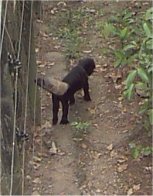
Tayra, Eira barbara
White-collared peccary
Order: Peccaries
Family: Tayassuidae
Species: Tayassu tajacu
Their uniformly grizzled gray-black upper parts, a faint but distinct collar or a stripe of pale yellow hairs, which extend from top to shoulder forward to the lower cheek, identifies Collared Peccary. Their mid-back from head to rump has a crest of long hairs, raised in excitement, and a large scent gland along the spine. Their hair is sparse; they have coarse bristles, banded black and white or yellow. Their head is large, sharply tapering from their large jowls to a narrow nose, their nostrils are in a naked, mobile disk small, protruding a little beyond the rostrum, and they have large canines, form distinct limps under lip, do not protrude.
Their eyes are small with a weak eye shine. They have reddish, small ears, covered with short hair. Their tail is tiny, or better said, not visible. Their forefeet have two large toes and two smaller rear toes that do not touch the ground (so they don’t appear in tracks), while their hind feet have two large toes and one smaller toe. Their young are grizzled reddish brown. They are pig-like, with a stout body, a thick neck and thin, delicate legs. The Collared Peccary is similar to the white-lipped peccary (T. pecary), Chacoan peccaries (Catagonus wagneri) Capybaras (Hydrochaeris hydrochaeris).
Their sound is usually quiet, but if surprised at close range may give very loud doglike barks, “Whoof” while in flight. They may also clack their teeth sharply. Their grunts (perhaps threats) are rarely heard.
They chew on nuts and snails with a loud cracking. Collared peccary are diurnal in the rainforest; they are terrestrial, and form groups of 1 to 20 members, usually 6 to 9. Loose groups often change in composition: males are sometimes solitary. In rainforests they feed on fruit, palm nuts, browse, snails, other invertebrates, and small vertebrates.
They release a strong odor, like cheese or chicken soup, especially when alarmed, and they frequently mark their trails by scraping the ground in front of a pole with their hooves, defecating in the scrape, and rubbing their back gland on the pole. They regularly use mud wallows and salt licks in favored, traditional spots. Collared peccaries are wary and surprisingly quiet and difficult to approach; they stampede in panic when they detect humans, and they are not dangerous (but those raised in captivity or habituated to man may be very aggressive, and inflict serious bite wounds).
They are found in different habitats: from dry, shrubby Sonora desert and chaco to deep rainforest. Note that their behavior is different in hot, dry habitats, where peccaries feed on cacti, and where they are active at night. In this habitat they do not use burrows. They live in Central and South America. They are widespread and locally common, but hunted intensively for meat, sport, and hides. Collared peccaries are rare or absent near many settlements but not threatened, in general.
Collared peccaries are also called Sajino, saíno, chancho de monte, jabali, tatabro, pakira, quequeo, baquiro de collar or chacharo in Spanish, and simply peccary in Belize.
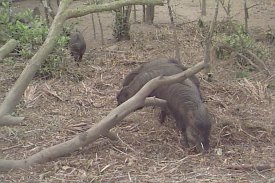
White collared peccari, Tayassu tajacu
Red-Brocket Deer
Order: Artiodactyla
Family: Cervidae
Species: Mazama americana
Their chestnut-red body and legs and their gray-brown neck and head identify red brocket deer. Their face doesn’t have any prominent markings; their forehead has a tuft of long, dark-tipped hairs, their ears are short, and thinly haired, the rim at inner base of the ears has a thin fringe of white hair, while the inner surface is naked and pinkish. Their large eyes shine a brilliant yellow-white at night. Only the males have antlers, which are short, straight, unbranched and directed backward…. Their legs are long and slender and as dark as their mid-back or even darker. Their tails are red above, white below and are raised vertically when in alarm to show undersurface.
Their throats at the jaw’s angle whitish. They exhibit a chestnut-colored belly, which is slightly paler at the sides. The hind thighs are white on the inner surface under their tails.
Their rump is large, higher than the shoulders, while their back has a slightly humped profile. The young are red with prominent or faint white spots, and a reddish belly. They are similar with the Gray brocket deer (M. gouazoubira), and the white-tailed deer (Odocoileus virginianus).
Red brocket deer are diurnal and nocturnal, terrestrial and solitary. They feed on fruit, fungi, browse and fallen flowers. Browse is mainly eaten when fruits are scarce in the dry season. They are adapted for life in the forest, with their low forequarters and simple antlers, which they can slip easily through dense vegetation.
They are found in mature and secondary rainforest, dry forest, gallery forest, forest edges, gardens, plantations and savannas near the forest edge. They live in Central and South America. Red brocket deer are hunted for meat and their populations have become scarce in some areas. However, they seem to persist where other large mammals have been exterminated, probably because of their solitary habits and their liking for dense vegetation.
They are also called Venado Colorado, corzuela roja, guazo, venado pardo, soche Colorado, cabro de monte, biche, tilopo, antilope, corzo, temazate, locho, redidia in Spanish, they call them antelopes in Belize, while their Mayan name is guitsizil.

Red brocket deer, Mazama americana
Nine-banded Armadillo
Order: Xenarthra
Family: Dasypodidae
Species: Dasypus novemcinctus
The Nine-banded Long-nosed Armadillos are identified by their hairless upper parts, covered with a bony armor, usually nine movable bands around their mid-body, and scales on movable bands on narrow triangles, and scales on the rest of their armor which are small and rounded. Their upper parts are usually gray, paling gradually to yellowish sides, but this color is often hidden by clay from burrowing. They have a long and narrow muzzle, large ears, set close together, almost touching at their bases, with no armor in between. Their tail is long, tapered and armored with distinct rings (the first 60%, of it), these rings are often with contrasting pale border. Their hind-feet have five claws, and their forefeet have four central claws, which are somewhat enlarged. Their under parts are almost hairless and pinkish yellow.
There are similar to the great long-nosed armadillos (D. kappleri) and seven-banded long-nosed armadillos (D. septemcinctus). Their sounds are not usually heard, but they snuffle while foraging. They are one of the noisiest travelers in the forest, treading heavily on dead leaves and shoving through the undergrowth. Nine Banded Long Nosed Armadillos are fast moving, nocturnal and moves about with a crashing sound. Although they are chiefly nocturnal, they may sometimes be diurnal, terrestrial, and solitary. They feed mostly on ants, termites, and other insects, but will eat many kinds of small animal prey, carrion, and some fruit, fungi, and other plant material.
Nine-banded armadillos are found throughout the forest but are most often seen in thickets and dense vegetation on sloping, well-drained firm land and rarely on flat plains subject to prolonged flooding. Small diggings in the soil show where an armadillo has been foraging. They walk or trot rapidly, often using well-worn pathways.
They are found in a wide range of mature and secondary habitats from deep rainforest to grassland and dry scrub. They are common and widespread and live in North, Central and South America. Unfortunately, they are hunted extensively for its excellent meat, which is often an important food source, so it is sometimes scarce in areas populated with subsistence hunters. Armadillos seem to withstand a heavy hunting pressure.
Their local Spanish names are: Armadillo, mulita, cusuco, pitero, and carachupa.
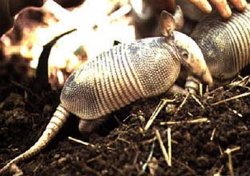
Nine banded armadillo, Dasypus novemcinctus
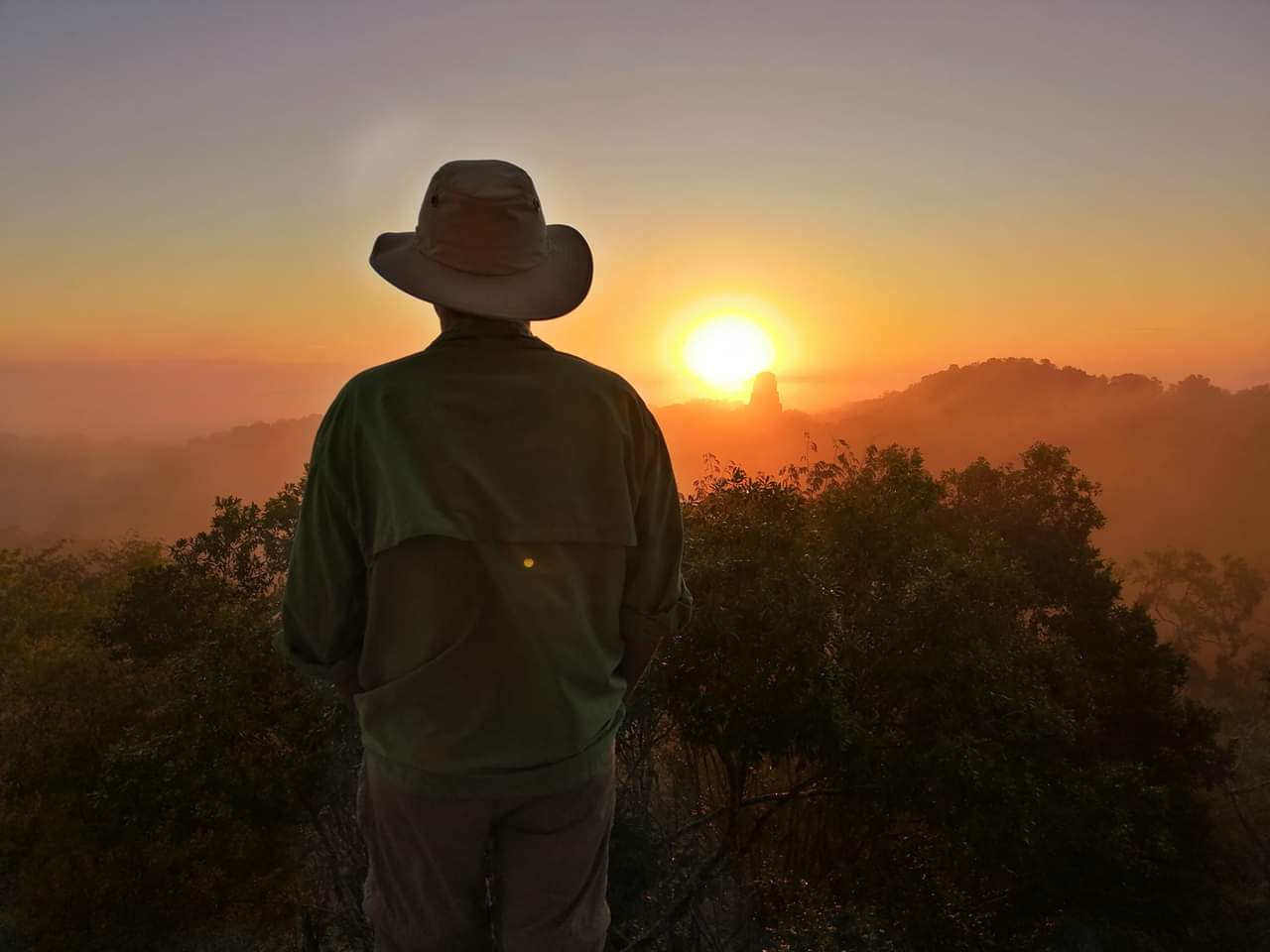

We hope you will enjoy www.tikalpark.com and its Spanish version www.parque-tikal.com
For reservations or more information write to us at tikalpark@tikalpark.com


| Home | About | Lodging | Plantation Tours | Birding | Tours | e-mail us | References | Site Map |